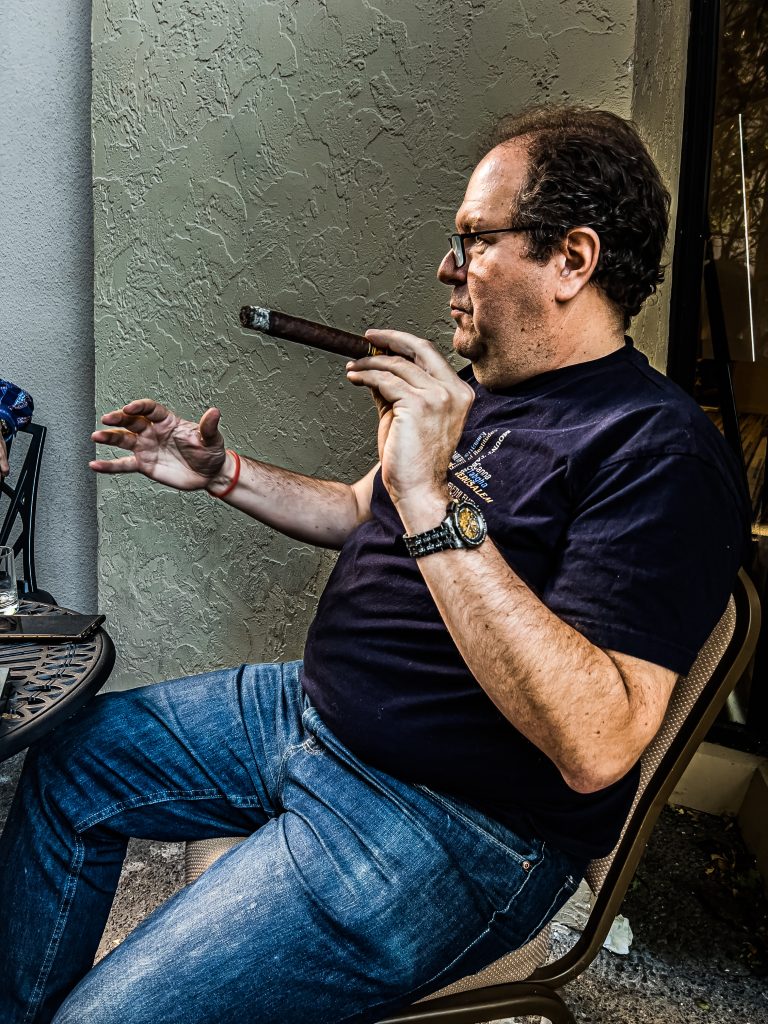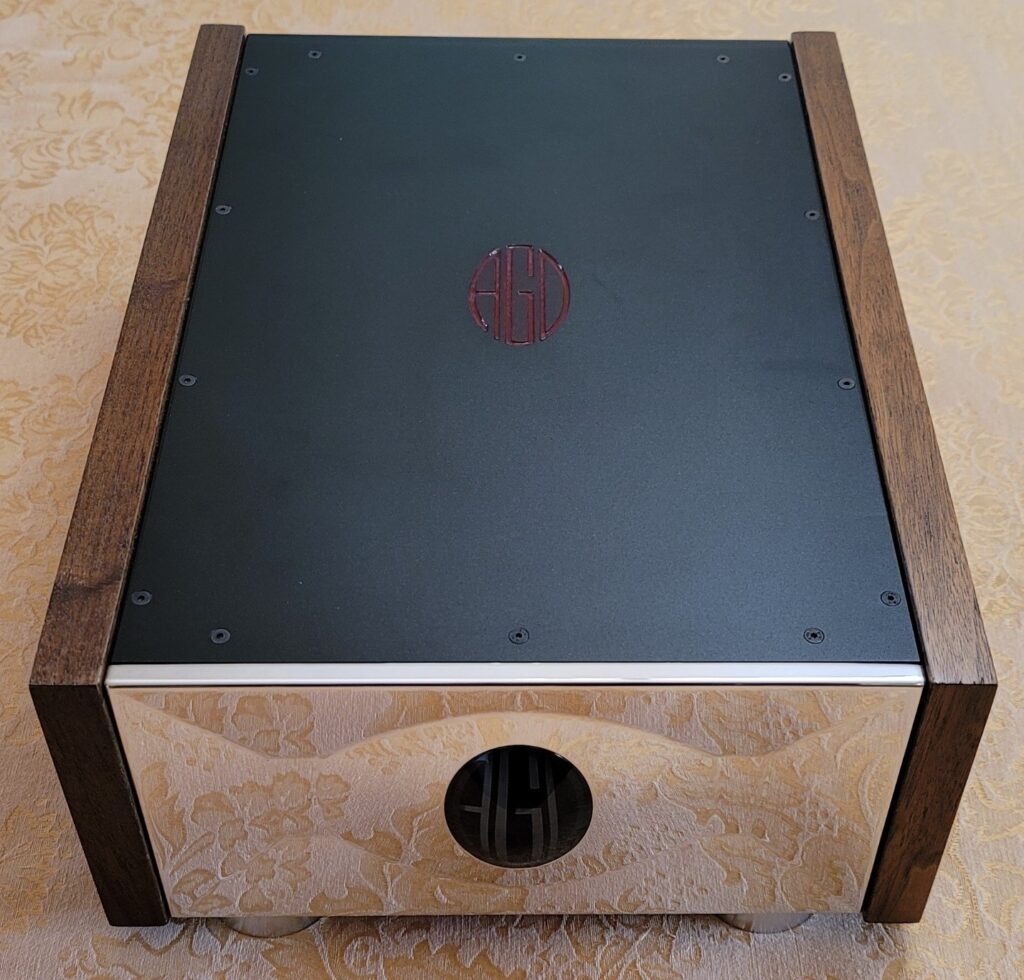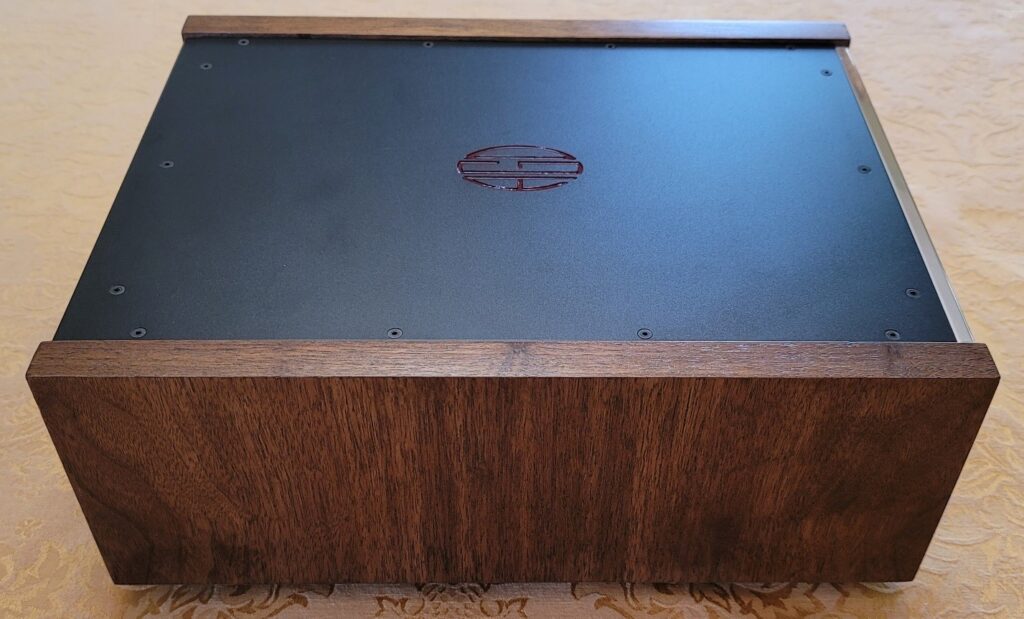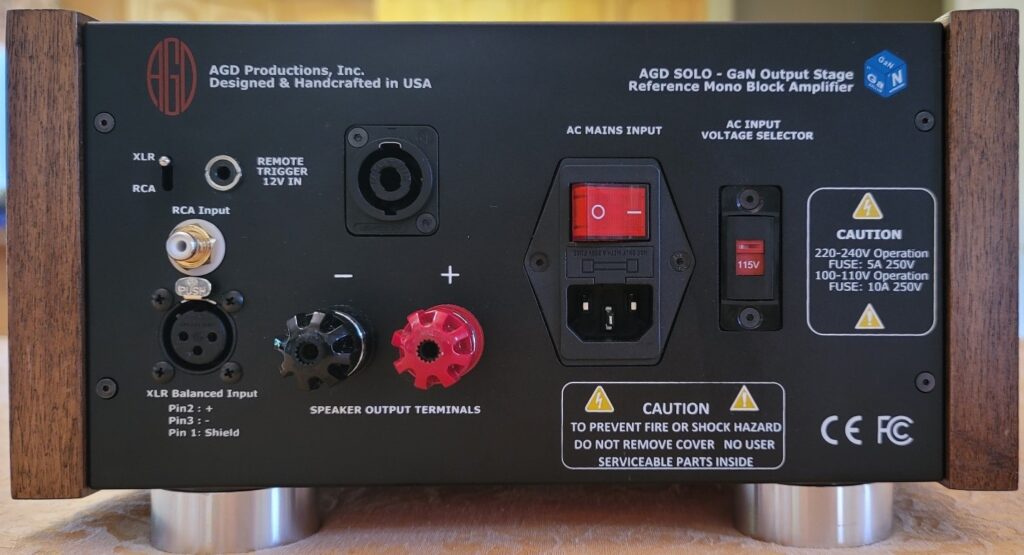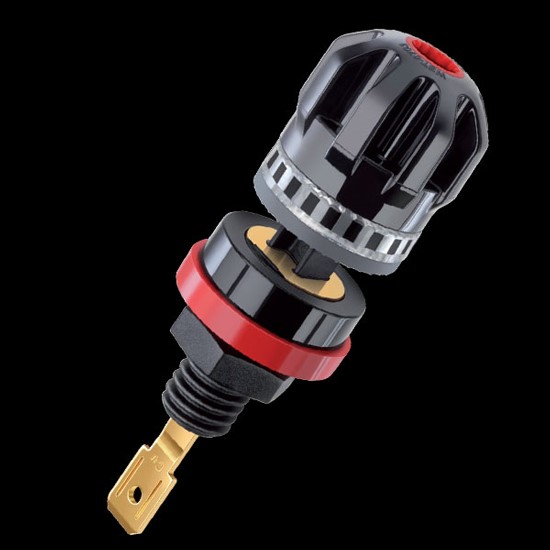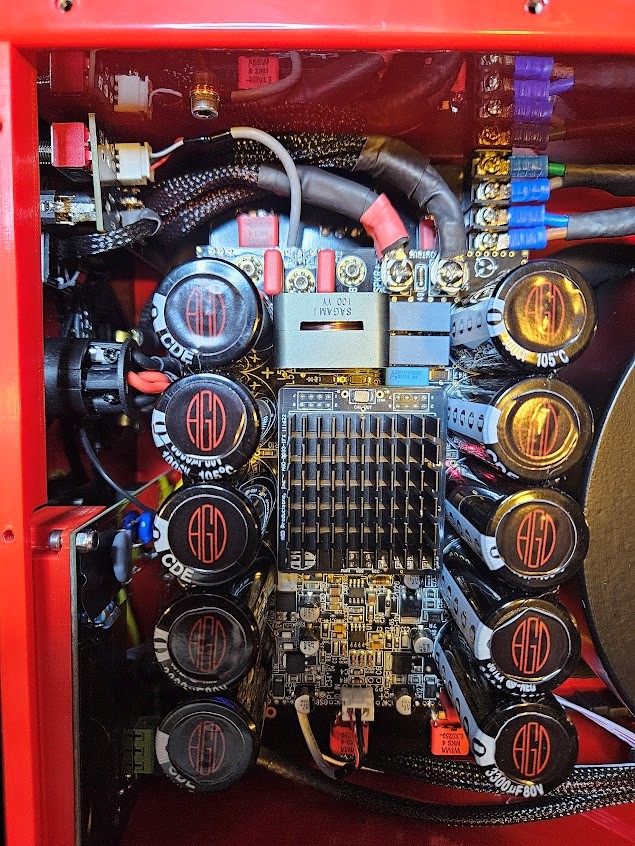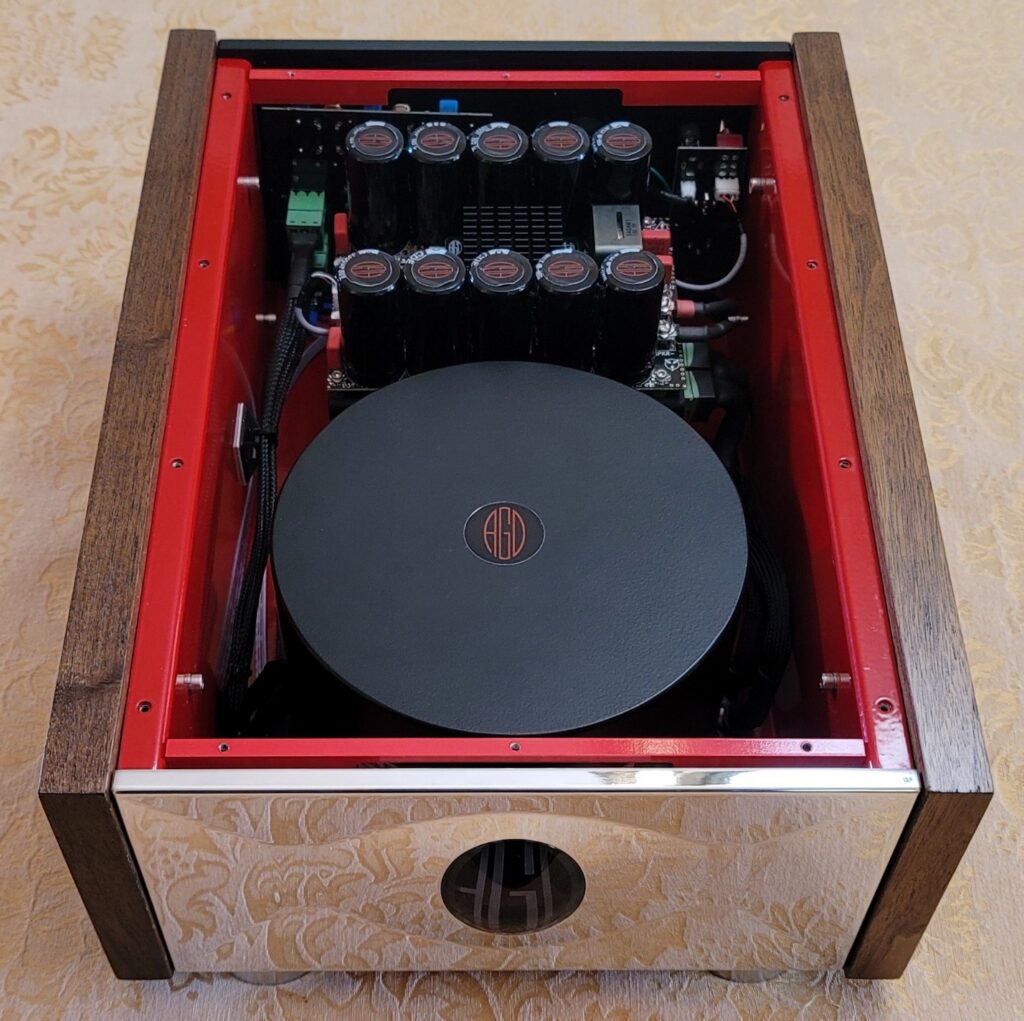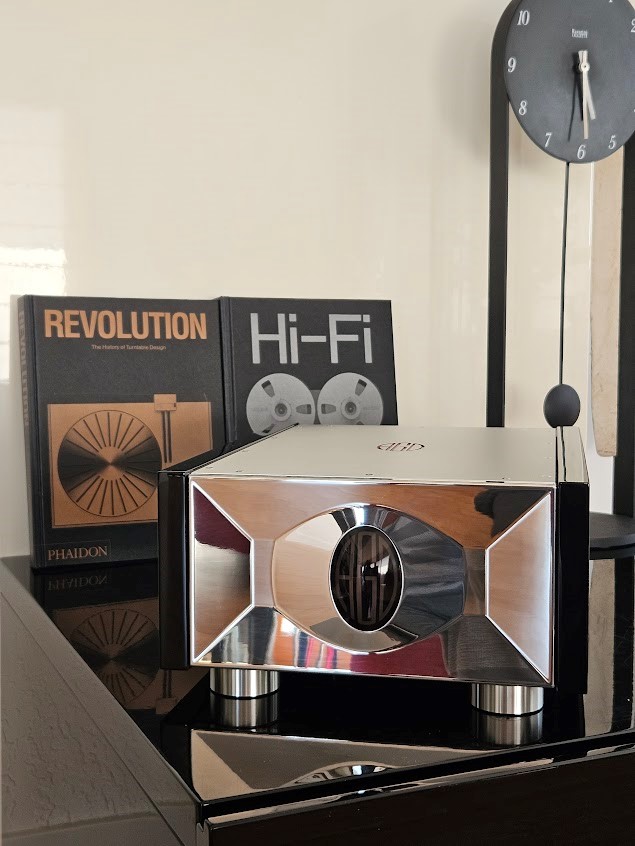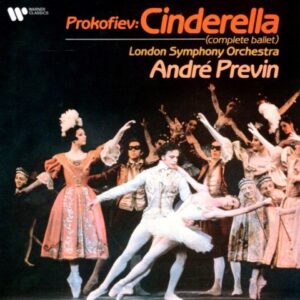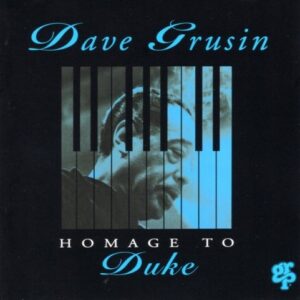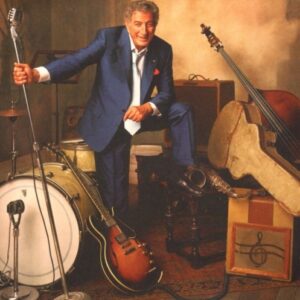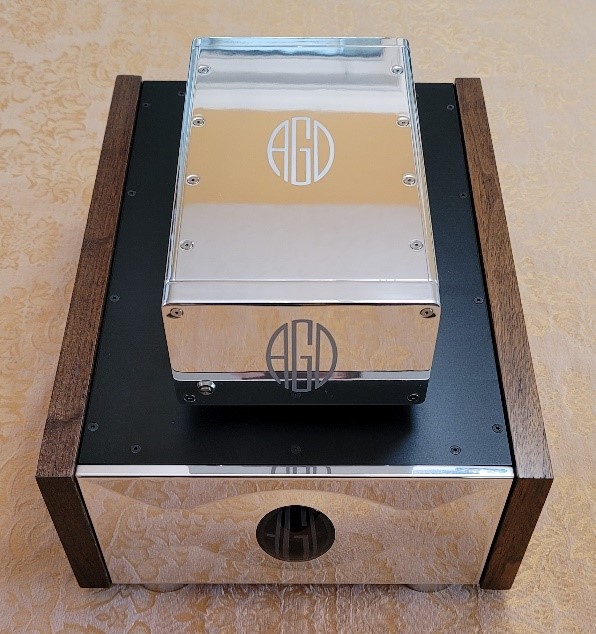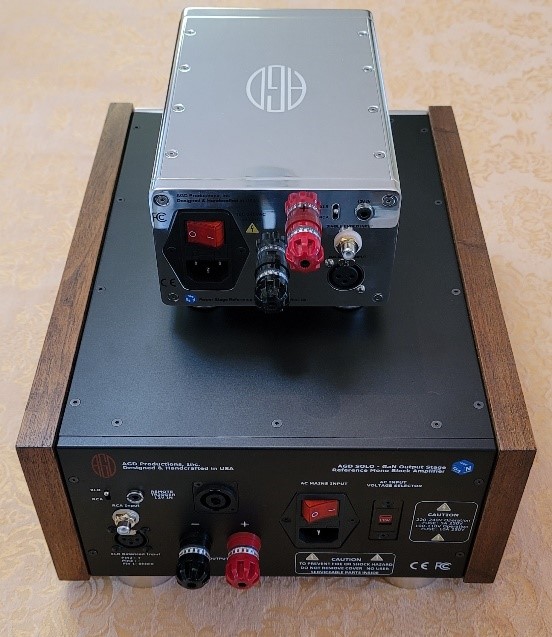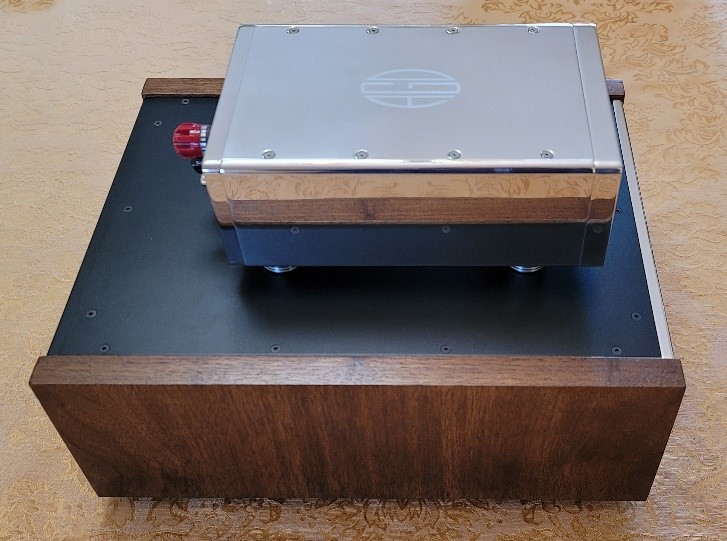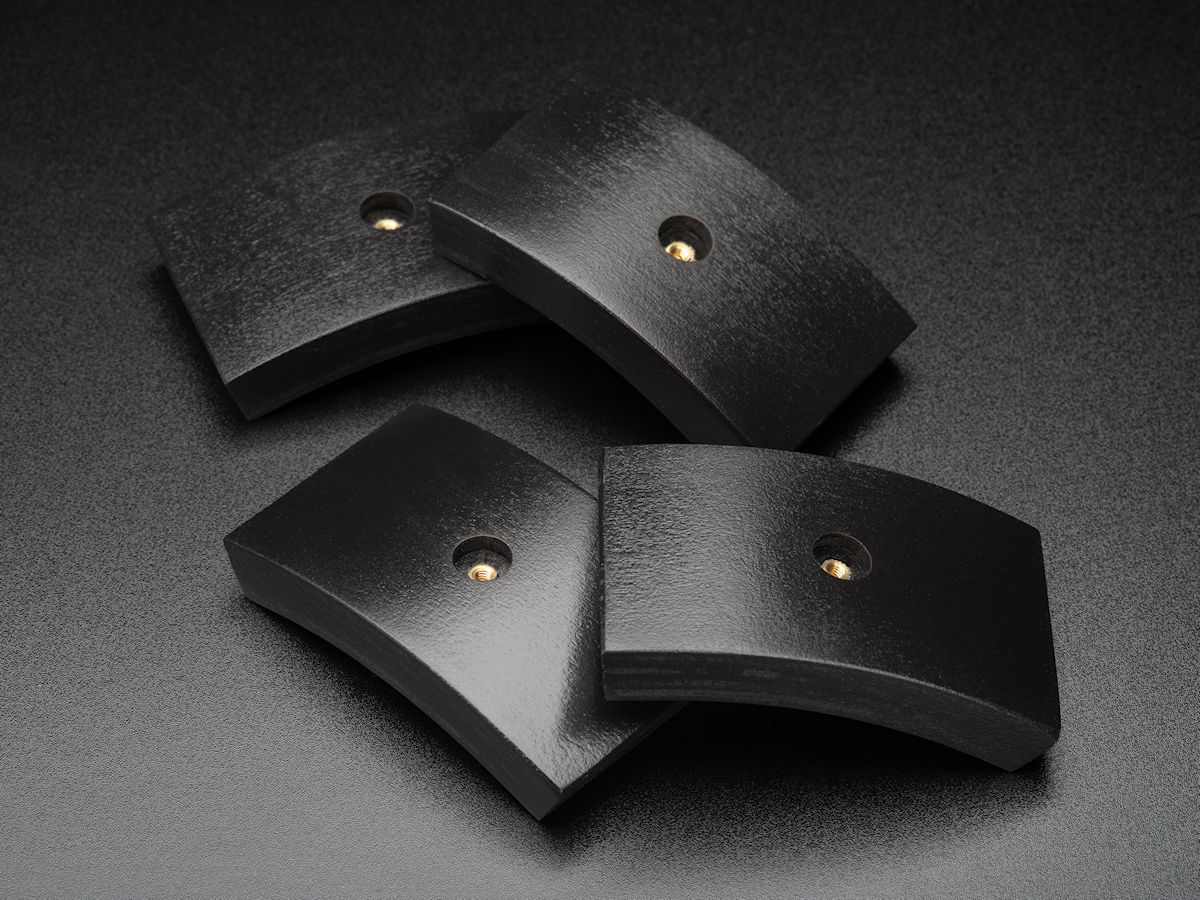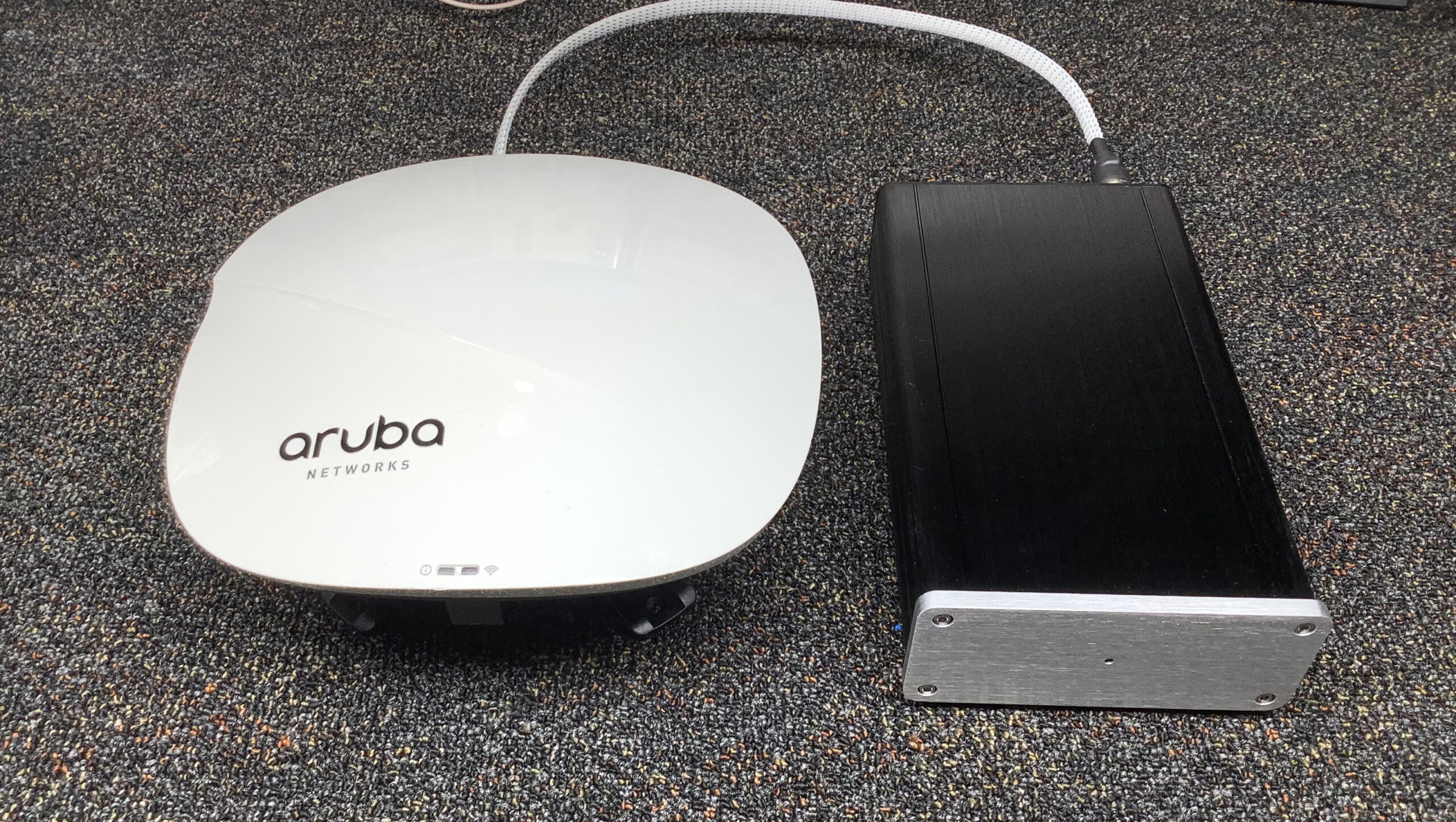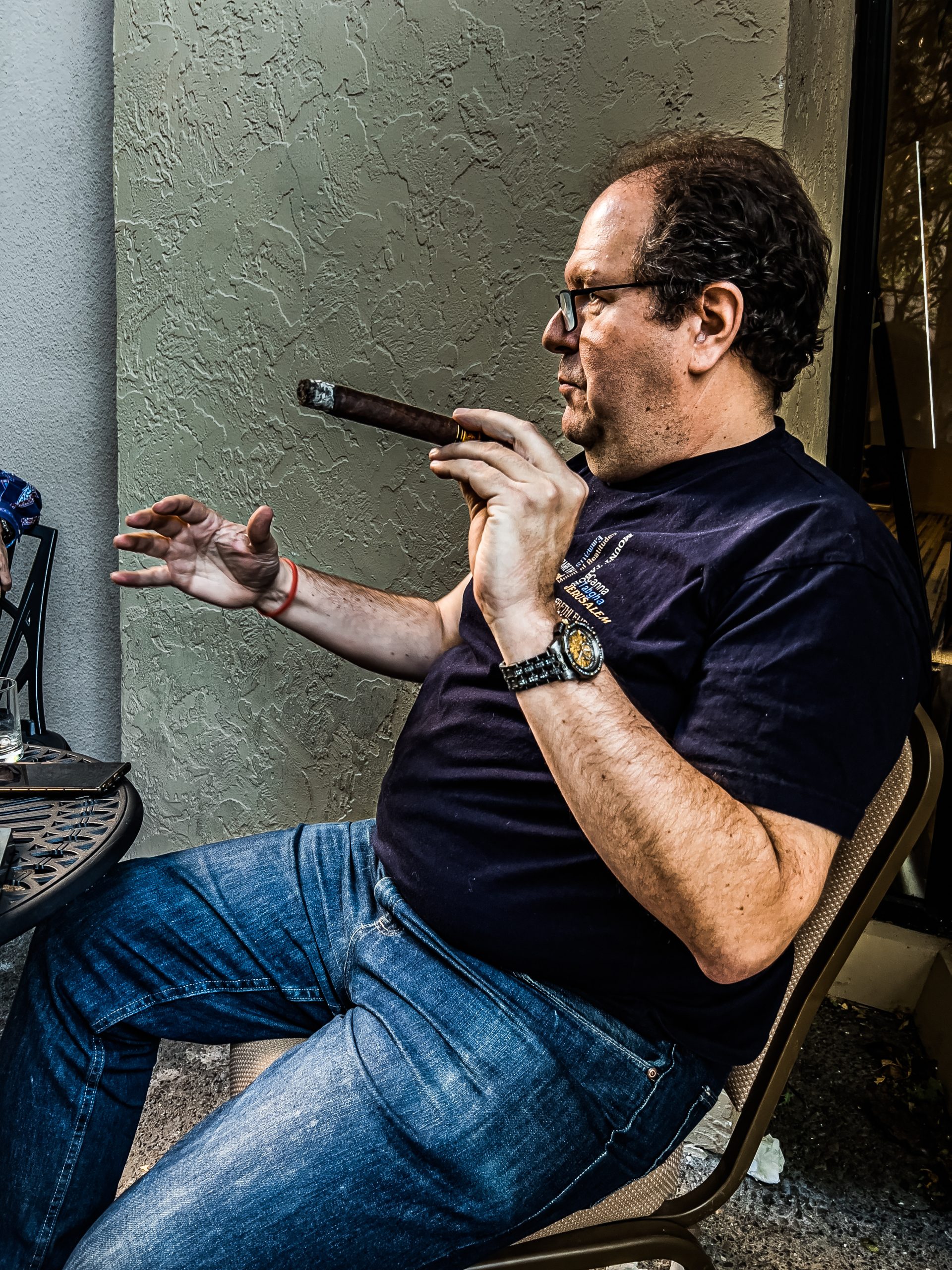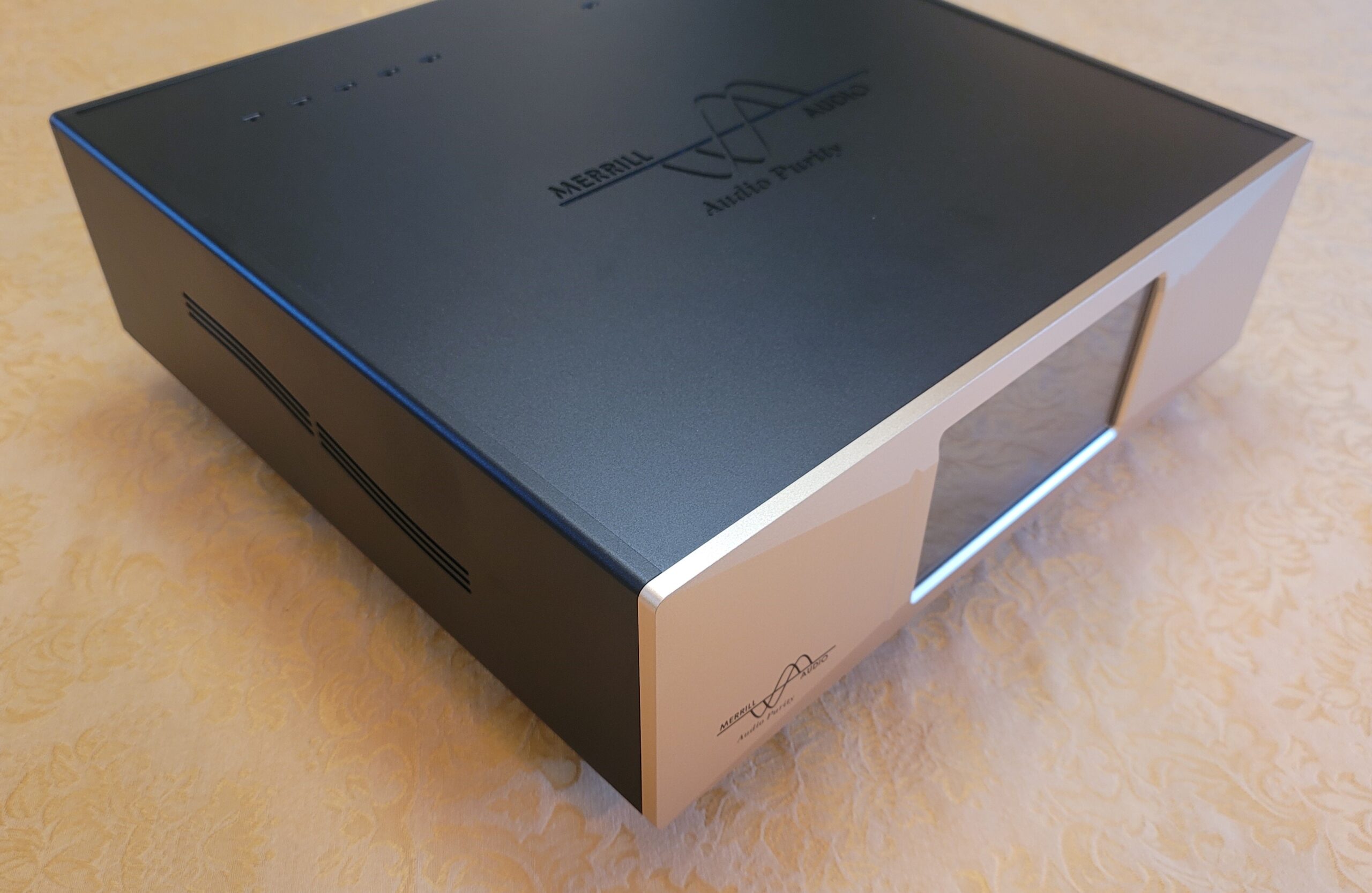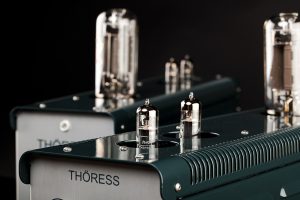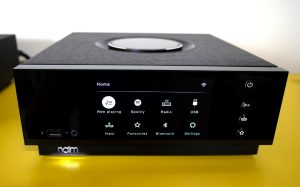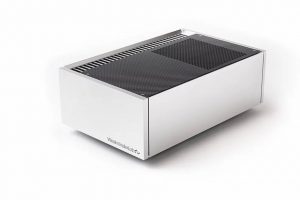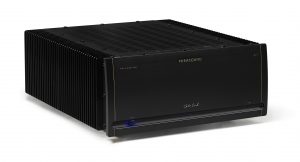Dean Waters with cigar at the Pacific Audio Fest 2023: a portrait. (Photograph and image processing by David W. Robinson)
I recently submitted an article reviewing the Alberto Guerra Designs (AGD) Duet monoblock amplifiers (HERE). They are in a word, wonderful.
Since then, I've been reviewing the Duet's big brothers, the AGD Solo Limited Edition monoblocks. The AGD Solo monoblocks are the top-of-the line offering from AGD. As much as I like the Duets, I have to confess that the Solo's are simply extraordinary. The Solo enclosure is both bold and makes a statement. The large circular logo on the front is the power switch and glows a nice warm orange when powered on. Much classier than a typical bright white LED that is so common. The solid wood panels on the side are designed to match the same wood work on the Sausalito Mk II High Fidelity speakers. If you happen to use those speakers, then this is a perfect aesthetic match. The wood is handsome regardless of what speakers you are using. Alternate wood trim colors are optional as well as the mirror-polished front panel, as shown here.
The AGD Solo Amplifier (front view)
The AGD Solo Amplifier (side view), showing the wood paneling
The back panel offers both unbalanced (RCA) and balanced (XLR) inputs with a toggle switch to select between the two. There is a voltage selector for the power supply and a standard 1/8" 12-volt trigger input jack. The speaker terminals are from WBT (WBT-0703Cu Nextgen) and are large and easy to work with.
They support both spade lug and banana plug type connectors. There is also a Neutrik SpeakON connector that can be used instead of the standard speaker terminals. These are twist-lock type connectors often found on larger high-current pro speakers.
Speaker binding post (image courtesy of WBT-USA).
Let's take a look at some of the technical details and then we'll talk about sound.
The Tech Stuff
In many ways, both the smaller Duets and the much larger Solos follow the same game plan in terms of design philosophy. They both use Gallium Nitride (GaN) MOSFETs in both the power supply and output stage. They both run at 800kHz. They both have upgradable output stages. The biggest single difference between the two is available power. The Solos have roughly twice the power as the Duets.
The upgradable output stage module is part of a key philosophy at AGD. Users should be able to protect their investments and be able to future-proof their purchases. This decision carries through the entire AGD line of monoblock amplifiers from the Audion model all the way up to the Solo series. This is a brilliant design. As new amplifiers are invented and brought to market, it is the output stages that generally change. Assuming the power supply within the amplifier is of good quality, then there should be no need to toss it out just because there is a new improvement with the output stage. This makes even more sense when we consider that Gallium Nitride MOSTFET technology in output stage semiconductors is about 10 years old whereas silicon semiconductors have been around for the better part of 60 years. In other words, in the coming years we're more likely to see generational improvements in GaN output stages compared to those made using traditional silicon semiconductor transistors. With AGD, an upgrade path is as simple as removing the cover and replacing a single socketed board within the chassis.
The MOSFET output stage (center) can be upgraded as new modules are developed.
The Solo's power is delivered via a huge (and heavy!) 700VA toroidal transformer. The transformer is encased in resin and housed in a dedicated enclosure, detached from the rest of the internal components to eliminate potential noise or vibration. Power is then fed into two banks of twenty-eight 6800µF capacitors (ten mounted in the near proximity to the GaN power stage board, and eighteen on the power supply board, which also houses the two 40A smart rectifier bridges (another custom design by AGD to get lower noise-lower losses than more traditional solutions).
This ensures smooth and consistent delivery to the power stage GaN MOSFETs, regardless of load demand.
Transformer (front) and power supply capacitors with the output stage (rear) with top case cover removed.
The increased frequency of the comparator wave that is used in amplifiers of this class (Class D) cannot be understated. To me, this is the 'secret sauce' that allows the AGD amplifiers to produce such a musical delivery. At 800kHz, there is no noticeable undershoot or overshoot of the input signal wave form. And thus little if any additional high frequency partials (noise) that need to be handled by the low-pass filters. This means less alteration ('fixing') of the amplified signal by the use of heavy-handed filtering.
The Sound
What strikes me right away about the AGD Solos is that they are completely effortless.
That is to say, the amplifier gets out of way of the music. These monoblocks are rated at 600W @ 4 ohms (300W @ 8 ohms), and capable to deliver >70A of peak current, so there's more than enough power for even the largest speakers and those that are hard to drive. I'm listening to a pair of Vivid Audio Kaya 90s and alternating those with a pair of QLN Signature Series loudspeakers. They Kaya 90s are 6-way (6 driver) speakers, and the Solos can easily drive them at earth-shaking volume levels without breaking a sweat. There's more than enough power. As a result, there's no noticeable change in sonic character from these amplifiers, regardless of the listening volume levels. The Solos sit back as if they are saying “Is that all you got?"
Since there is so much additional power available, the result is a pure listening experience with gobs of presence unmatched staging. The 3D staging is outstanding. Dare I say it's the best I've experienced in my home setup. By far. I close my eyes and the speakers disappear. So do the amplifiers for that matter. There's only music. With closed eyes, I couldn't point to the speakers, but I sure could point to the harpist, the timpani, the violas, etc. And it's not simply a left-to-right type of staging. It's a three-dimensional staging. The percussionists are behind the center of the orchestra. The harpist is to the left and just behind the violin section. This sense of multi-dimensional staging put a huge smile on my face.
Some stand-out recordings were Prokofiev's Cinderella with Andrè Previn and the London Symphony. Even with this 1983 recording, I could easily identify exactly where, in 3D space, each orchestra member was located.
In Debussy's La Mer, also Andrè Previn and the London Symphony, I simply reveled in the lush texture and simple beauty that is Debussy. Then of course I had to switch to the 1958 Solti recording on Decca of the first scene of Das Rheingold. Tons more classical has been enjoyed on these monoblocks... too many titles to name here.
Switching over to Jazz and Blues, I loved the openness and cleanliness of Dave Grusin's Homage to Duke. The staging is so good with the AGD's that I could hear the group playing as if they were in the room. Amazing precision and clarity.
Then a 1990 Telarc live recording of the Oscar Peterson trio recorded at the Blue Note. Also great. I'm quite partial to anything Telarc from that time era. Classical or Jazz, they simply know what they are doing and make really great recordings.
Tony Bennett's Playin' With My Friends album was particularly wonderful because I could immediately tell where each singer and instrumentalist was standing during the recording. This album features Mr. Bennett singing duets with ten other top singing stars. In each track I knew exactly how they were arranged in the studio. It was really uncanny. The amplifiers made themselves vanish along with the rest of the gear. All this while the amplifiers were cruising just above idle. I listened for hours and never had the slightest hint of ear fatigue.
Conclusion
After multiple dedicated listening sessions over many weeks, with dozens and dozens of albums, the amplifiers never rose more than a few degrees ambient room temperature. These will happily drive whatever speakers you might choose to use. These could very well be the last amplifiers you'd ever need to buy. I'd be hard pressed to find a need for more power than these can offer and the ability to upgrade the sound stage in years ahead makes this a no-brainer.
Final Thoughts
If I had to choose between the AGD Duets and the AGD Solos, that would be a tough choice. They are both exceptional. They both make prodigious use of Gallium Nitride (GaN) in their power and output stages. They both run at 800kHz signaling rate. I recently penned a separate article about the AGD Duets where I took more of a deep-dive into the technical features of the AGD monoblocks. What was written about the Duets also applies to the Solos. You can read that article HERE.
The real difference for me between the Duets and the Solos is the extra power offered by the Solos, and hence the extra available headroom. The Solos offer more power than I could ask for. There is also a more sense of effortlessness in the delivery afforded by the additional headroom. Tough call, really.
If budget allows, the Solos are a best-in-class offering as far as I'm concerned. The Duets are also an excellent choice, especially if you don't need to power huge or hard to drive speakers. Also, if you're limited on space, as the Duets are wonderfully compact for what they have to offer. Either way, I would suggest that AGDs—either the Duets or the Solos—be added to your 'must consider' list.
Specifications
- Nominal Output, 20Hz to 20kHz @ 4Ω: 600Watts
- Max Output at 0.1% THD+N, 1kHz @ 8Ω: 300Watts
- THD+N 10W/1kHz: <0.005%
- Input Impedance: 40kOhm (600Ohm available upon request)
- GaN Power Module PWM Frequency: ~800kHz
- Dimensions: 14.5" × 11.25" × 6.5" (370 x 285 x 165mm)
- Weight: 45lbs (20kg)
Solo Monoblock Amps
Retail: $23,500 (per pair)
AGD
Equipment list used for this review: (borrowed items are in bold)
- AGD Solo Limited Edition GaN-Powered monoblock amplifiers
- Mola Mola Tambaqui DAC
- Mola Mola Makua preamplifier
- Vivid Audio Kaya 90 loudspeakers
- QLN Signature loudspeakers
- Kubala-Sosna Realization Series speaker cables
- RSX Technologies Beyond Series power cables
- RSX Technologies Benchmark Series Interconnect cables
- Sony UBP-X800M2 CD/SACD transport
- Windows™ PC w/ Audirvāna - DSD streaming server
- PS Audio PowerPlant 15 power regenerator




